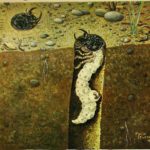Last updated on September 2nd, 2020

From: Saunders E., 1896 – The Hymenoptera Aculeata of the British Islands.
The small Aculeate wasps of the genus Methocha are slender animals with wingless, antlike females and winged males, and they belong to the Methochinae, a subfamily of the Thynnidae wasps, Hymenoptera Apocrita.
Thynnidae – also known as flower wasps, roll-wasps, Rollwespen – are a family of solitary wasps whose larvae are almost universally specialized ectoparasitoids on various beetle larvae, especially Scarabaeoidea and Cicindelidae.
Most thynnid species are small, but they can be up to 30 mm long.
 Taxonomy
Taxonomy
Until recently, some of the constituents of this family were classified in the family Tiphiidae, but multiple studies have independently confirmed that thynnids are a separate lineage. [from: Wikipedia].
Class Insecta
![]()
![]()
![]()
![]() Order Hymenoptera
Order Hymenoptera
![]()
![]()
![]()
![]()
![]()
![]() Suborder Apocrita
Suborder Apocrita
![]()
![]()
![]()
![]()
![]()
![]()
![]()
![]() Series Aculeata
Series Aculeata
![]()
![]()
![]()
![]()
![]()
![]()
![]()
![]()
![]()
![]() Superfamily Thynnoidea
Superfamily Thynnoidea
![]()
![]()
![]()
![]()
![]()
![]()
![]()
![]()
![]()
![]()
![]()
![]() Family Thynnidae
Family Thynnidae
![]()
![]()
![]()
![]()
![]()
![]()
![]()
![]()
![]()
![]()
![]()
![]()
![]()
![]() Subfamily Anthoboscinae
Subfamily Anthoboscinae
![]()
![]()
![]()
![]()
![]()
![]()
![]()
![]()
![]()
![]()
![]()
![]()
![]()
![]() Subfamily Diamminae
Subfamily Diamminae
![]()
![]()
![]()
![]()
![]()
![]()
![]()
![]()
![]()
![]()
![]()
![]()
![]()
![]() Subfamily Methochinae
Subfamily Methochinae
![]()
![]()
![]()
![]()
![]()
![]()
![]()
![]()
![]()
![]()
![]()
![]()
![]()
![]()
![]()
![]()
![]()
![]() Genus Methocha Latreille, 1804
Genus Methocha Latreille, 1804
![]()
![]()
![]()
![]()
![]()
![]()
![]()
![]()
![]()
![]()
![]()
![]()
![]() Subg. Methocha Latreille, 1804
Subg. Methocha Latreille, 1804
![]()
![]()
![]()
![]()
![]()
![]()
![]()
![]()
![]()
![]()
![]()
![]()
![]() Subg. Dryinopsis Brues, 1910
Subg. Dryinopsis Brues, 1910
![]()
![]()
![]()
![]()
![]()
![]()
![]()
![]()
![]()
![]()
![]()
![]()
![]() Subg. Andreus Ashmead, 1903
Subg. Andreus Ashmead, 1903
![]()
![]()
![]()
![]()
![]()
![]()
![]()
![]()
![]()
![]()
![]()
![]()
![]()
![]()
![]()
![]()
![]()
![]() Genus Karlissa Krombein, 1979
Genus Karlissa Krombein, 1979
![]()
![]()
![]()
![]()
![]()
![]()
![]()
![]()
![]()
![]()
![]()
![]()
![]()
![]() Subfamily Myzininae
Subfamily Myzininae
![]()
![]()
![]()
![]()
![]()
![]()
![]()
![]()
![]()
![]()
![]()
![]()
![]()
![]() Subfamily Thynninae
Subfamily Thynninae
Description
Thynnid species are winged wasps, except for Diamminae, Methochinae and Thynninae whose females are wingless. Methochinae have an elongated thorax subdivided in three segments, antennas with 12 flagellomeres in females and 13 flagellomeres in males.
Go to the page Morphology of Methocha wasps.
Biology
Thynnid wingless females hunt ground-dwelling (fossorial) beetle larvae, or (in one case) mole crickets. The prey is paralysed with the female’s sting and an egg is laid on it so the wasp larva has a ready supply of food.
 Methocha females prey on ant-eating cicindelid larvae, which are commonly found in burrows along sandy soils. Initially, the wasp enters the burrow of the tiger beetle larva and is quickly caught in the predator’s deadly mandibles. But, thanks to its thin body that mimics an ant, it is able to escape the predator’s mandibles and to sting the larva in order to paralyze it. During the fight, the beetle larva can leave its burrow, but after the sting the Methocha wasp is able to drag the larva back into its own burrow. Once there, the wasp lays and glues an egg on the paralyzed tiger beetle larval body, then seals the entrance to the burrow with soil particles. The Methocha larva develops within 2-3 weeks and eats the paralyzed larva.
Methocha females prey on ant-eating cicindelid larvae, which are commonly found in burrows along sandy soils. Initially, the wasp enters the burrow of the tiger beetle larva and is quickly caught in the predator’s deadly mandibles. But, thanks to its thin body that mimics an ant, it is able to escape the predator’s mandibles and to sting the larva in order to paralyze it. During the fight, the beetle larva can leave its burrow, but after the sting the Methocha wasp is able to drag the larva back into its own burrow. Once there, the wasp lays and glues an egg on the paralyzed tiger beetle larval body, then seals the entrance to the burrow with soil particles. The Methocha larva develops within 2-3 weeks and eats the paralyzed larva.
Distribution
The widespread Methochinae include only few species, which are absent from the Australian region.
Go to the page World distribution of Methocha wasps.
Copyright, Authorship, and Ownership statements
All text and images are copyright ©️ Chrysis.net unless otherwise stated - please see individual cases for authorship and copyright details. The specimens pictured are from the authors' or other collaborators' personal collections and from the collections of various museums. Unless otherwise specified, the whole content of this web site is for personal, non-commercial, scientific, and educational purposes given proper accreditation to the page from which they were derived are provided, and under Chrysis.net Terms and Conditions.
For citation purposes
Agnoli G.L. (2025) An overview of Methocha wasps, in: Chrysis.net website. Interim version 31 March 2025, URL: https://www.chrysis.net/resources/methocha/overview/.







